
26 Trường Đại học Nông Lâm TP. Hồ Chí Minh
Tạp chí Nông nghiệp và Phát triển 24(1) www.jad.hcmuaf.edu.vn
Effects of probiotic supplementation in rearing mud crab larvae (Scylla paramamosain
estampador, 1949)
Vu H. Le1, Tuyen B. Cao2, & Bac V. Nguyen3*
1Faculty of Agriculture and Aquaculture, Bac Lieu University, Bac Lieu, Vietnam
2Faculty of Education, Bac Lieu University, Bac Lieu, Vietnam
3Faculty of Agricultural Economics, Ca Mau Community College, Ca Mau, Vietnam
ARTICLE INFO ABSTRACT
Research Paper
Received: March 29, 2024
Revised: July 30, 2024
Accepted: August 08, 2024
Keywords
Bacillus subtilis
Lactobacillus acidophilus
Mud crab
Probiotic
Scylla paramamosain
*Corresponding author
Nguyen Viet Bac
Email:
nvbac87@gmail.com
The research was conducted to evaluate effects of probiotics
supplementationon growth performanceand survival rateof mud
crab (Scylla paramamosain) larvae. The experiment was arranged
in a completely randomized design with 4 diets supplemented
with various probiotics: (i) Control (w/o supplementation), (ii)
L. acidophilus, (iii) B. subtilis, and (iv) a mixture of L. acidophilus
and B. subtilis. A total of 12 composite tanks were filled with 60
L sterilized saline water (salinity 26 ppt) with a stocking density
of 200 larvae/L and water exchange was controlledevery 3 days
(25% of the water volume). The probiotics(104 CFU/mL) were
added separately to the experimental tanks every 3 days over a
culture period. The L. acidophilus supplementation resulted in
significantly higher total probiotics density (16.38 x 104 CFU/
mL) compared with the control (6.37 x 104 CFU/mL) (P < 0.05).
Furthermore, the control showedthe highest Vibrio spp. density
(6.67 x 103 CFU/mL) which differed significantly (P < 0.05)
from remaining treatments with probiotics supplementation.
The larval stage index (LSI) of mud crab larvae in probiotic-
supplemented treatments did not differ significantly (P > 0.05).
The control hadthe lowest Crablet1 ’s survival rate (7.51%) which
differed significantly from remaining treatments (P < 0.05). In
contrast, the L. acidophilus-supplemented treatment achieved the
highest survival rate (10.04%). In conclusion, the obtained results
suggested that L. acidophilus supplementation was considered the
most potentialapproach to mud crab larvae production.
Cited as: Le, V. H., Cao, T. B., & Nguyen, B. V. (2025). Effects of probiotic supplementation in
rearing mud crab larvae (Scylla paramamosain estampador, 1949). The Journal of Agriculture and
Development 24(5), 26-37.

Trường Đại học Nông Lâm TP. Hồ Chí Minh 27
Tạp chí Nông nghiệp và Phát triển 24(1) www.jad.hcmuaf.edu.vn
Ảnh hưởng của bổ sung chế phẩm sinh học trong ương ấu trùng cua biển (Scylla paramamosain
estampador, 1949)
Lê Hoàng Vũ1, Cao Bích Tuyền2 & Nguyễn Việt Bắc3*
1Khoa Nông Nghiệp và Thủy Sản, Trường Đại Học Bạc Liêu, Bạc Liêu
2Khoa Sư Phạm, Trường Đại Học Bạc Liêu, Bạc Liêu
3Khoa Kinh Tế Nông Nghiệp, Trường Cao Đẳng Cộng Đồng Cà Mau, Cà Mau
THÔNG TIN BÀI BÁO TÓM TẮT
Bài báo khoa học
Ngày nhận: 29/03/2024
Ngày chỉnh sửa: 30/07/2024
Ngày chấp nhận: 08/08/2024
Từ khóa
Bacillus subtilis
Chế phẩm vi sinh
Cua biển
Lactobacillus acidophilus
Scylla paramamosain
*Tác giả liên hệ
Nguyen Viet Bac
Email:
nvbac87@gmail.com
Nghiên cứu này nhằm đánh giá ảnh hưởng của các loại chế phẩm
sinh học lên tăng trưởng và tỷ lệ sống của ấu trùng cua biển (Scylla
paramamosain). Thí nghiệm gồm 4 nghiệm thức: (i) Nghiệm
thức đối chứng (không bổ sung chế phẩm sinh học), (ii) bổ sung
L. acidophilus, (iii) bổ sung B. subtilis, (iv) bổ sung kết hợp L.
acidophilus và B. subtilis, mỗi nghiệm thức được lặp lại 3 lần và
bố trí hoàn toàn ngẫu nhiên. Ấu trùng được ương trong bể nhựa
60 L với mật độ 200 con/L, độ mặn 26 ppt và bể ương được thay
3 ngày/lần, với 25% thể tích nước. Trong suốt thời gian ương bể
ương được bổ sung chế phẩm vi sinh mỗi 3 ngày/lần với mật độ
104 CFU/mL. Kết quả cho thấy mật độ vi khuẩn tổng cao nhất ở
nghiệm thức bổ sung L. acidophilus (16,38 x 104 CFU/mL) khác
biệt có ý nghĩa thống kê (P < 0,05) so với nghiệm thức đối chứng
(6,37 x 104 CFU/mL). Mật độ vi khuẩn Vibrio spp. ở nghiệm thức
đối chứng cao nhất (6,67 x 103 CFU/mL) khác biệt có ý nghĩa (P
< 0,05) so với các nghiệm thức có bổ sung chế phẩm vi sinh. Chỉ
số biến thái (LSI) của ấu trùng của các nghiệm thức sử dụng vi
sinh khác biệt không có ý nghĩa thống kê giữa các nghiệm thức (P
> 0,05). Tỷ lệ sống đến Cua1 thấp nhất ở nghiệm thức đối chứng
(7,51%) khác biệt có ý nghĩa thống kê (P < 0,05) so với các nghiệm
thức còn lại. Nghiệm thức bổ sung L. acidophilus cho tỷ lệ sống
cao nhất (10,04%). Kết quả nghiên cứu này cho thấy bổ sung L.
acidophilus trong ương ấu trùng cua biển đạt hiệu quả cao nhất.

28 Trường Đại học Nông Lâm TP. Hồ Chí Minh
Tạp chí Nông nghiệp và Phát triển 24(1) www.jad.hcmuaf.edu.vn
Các dòng vi khuẩn thuộc họ Bacillus,
Lactobacillus, Enterococcus, Aeromonas,
Alteromonas, Arthrobacter, Bifidobacteria,
Clostridium, Microbacteria, Paenibacillus,
Phaeobacter, Pseudoalteromonas, Pseudomonas,
Rhodosporidium, Roseobacter, Streptomyces và
Vibrio đã chứng minh được hiệu quả của chúng
khi sử dụng cho các loài động vật thuỷ sản (Ringø
& ctv., 2018; Dawood & ctv., 2019; Ringø & ctv.,
2019). Trong đó, có một số họ đã được ứng dụng
cho cua biển ở giai đoạn cua giống và cua trưởng
thành (Tran & Li, 2022), với hình thức chủ yếu
là bổ sung vào thức ăn hoặc bổ sung vào môi
trường nước (Wu & ctv., 2014; Yeh & ctv., 2014;
Yang & ctv., 2019). Tuy nhiên, cho đến hiện nay
việc ứng dụng chế phẩm sinh học trong ương
ấu trùng cua biển còn khá ít (Talib & ctv., 2017;
Gunarto & ctv., 2021; Gunarto & ctv., 2024). Do
đó, nghiên cứu này được thực hiện nhằm xác
định được loại chế phẩm vi sinh thích hợp bổ
sung vào nước ương ấu trùng cua biển đạt tỷ lệ
sống đến Cua1 cao nhất. Qua đó, góp phần nâng
cao hiệu quả ương ấu trùng cua biển và cung cấp
nguồn cua giống có chất lượng tốt cho nuôi cua
thương phẩm.
2. Vật Liệu và Phương Pháp Nghiên Cứu
2.1. Nguồn nước thí nghiệm
Nước sử dụng trong thí nghiệm có độ mặn
26 ppt, được mua từ cửa biển Gành Hào, Bạc
Liêu. Nước được lọc qua than hoạt tính và lõi
lọc gòn 1 µm (MBC, Graver USA), sau đó đi
qua hệ thống đèn cực tím UV-C (254 nm) và xử
lý EDTA (10 g/m3). Độ kiềm được duy trì ở mức
100 - 120 mg CaCO3/L bằng NaHCO3. Trong
suốt thời gian thí nghiệm, tất cả các bể ương
được sục khí liên tục và thay nước 3 ngày/lần
với tỷ lệ 25%, chế phẩm vi sinh được bổ sung
vào bể ương sau khi thay nước.
1. Giới Thiệu
Cua biển (Scylla paramamosain) loài đối
tượng thủy sản có giá trị kinh tế cao vào được
nuôi ở nhiều nơi trên thế giới, trong đó có Việt
Nam. Những năm gần đây, diện tích nuôi cua
biển ngày càng mở rộng dẫn đến nguồn giống
cua biển từ tự nhiên đang giảm mạnh do việc
khai thác quá mức để cung cấp cho nghề nuôi
(Liew & ctv., 2024). Bên cạnh đó, việc phát triển
công nghệ trại giống cho mục đích sản xuất giống
cua biển ở quy mô thương mại cũng được tập
trung nghiên cứu. Tuy nhiên, tỷ lệ sống của ấu
trùng cua biển chịu ảnh hưởng nhiều yếu tố như:
nhiễm khuẩn từ cua mẹ và môi trường (Talpur
& ctv., 2011; Wu & ctv., 2016), chất lượng nước
(Li & ctv., 2012), mật độ ương ấu trùng (Tran &
Le, 2018) hay đặc điểm dinh dưỡng (Pavasovic,
2004; Tran & Le, 2017).
Gần đây, chế phẩm vi sinh đã được sử dụng
và mang lại hiệu quả tích cực trên nhiều loài
động vật thủy sản (Ringø, 2020). Một số nghiên
cứu gần đây đã cho thấy hiệu quả của việc sử
dụng chế phẩm vi sinh giúp cải thiện tăng
trưởng, cải thiện dinh dưỡng và hoạt động của
enzyme vào quá trình tiêu hóa của vật chủ, giúp
vật chủ tăng cường các phản ứng miễn dịch và
chống lại bệnh (Tran, 2018; Poolsawat & ctv.,
2020). Chế phẩm vi sinh đóng vai trò như chất
kích thích tăng trưởng, chất kích thích miễn
dịch trên cá, tôm và chống lại mầm bệnh ở cua,
cũng như kiểm soát chất lượng nước bể nuôi
(Talpur & ctv., 2013). Trong bối cảnh những
năm gần đây, nếu yêu cầu thực hành canh tác
hiệu quả và thân thiện với môi trường được đặt
lên hàng đầu thì probiotic ngày càng được sử
dụng rộng rãi hơn (Dawood & ctv., 2019).

Trường Đại học Nông Lâm TP. Hồ Chí Minh 29
Tạp chí Nông nghiệp và Phát triển 24(1) www.jad.hcmuaf.edu.vn
Chế phẩm sinh học L. acidophilus (Han Wha
Pharma, Hàn Quốc) và B. subtilis (Genchem
polytase, Đài Loan) được bổ sung định kỳ 3
ngày/lần với liều lượng 104 CFU/mL sau mỗi lần
thay nước. Thí nghiệm được kết thúc sau khi ấu
trùng chuyển sang giai đoạn Cua1 hoàn toàn.
Ấu trùng cua được cho ăn ấu trùng Artemia 6
lần/ngày (lúc 6 giờ, 10 giờ, 14 giờ, 18 giờ, 22 giờ
và 2 giờ) với chế độ cho ăn và liều lượng được
trình bày chi tiết ở Bảng 1. Chất DHA (Protein
Selco của INVE Bỉ, thành phần gồm protein: tối
thiểu 27%; chất béo: tối thiểu 29%; n-3 HUFA:
tối thiểu 80 mg/g khối lượng khô, DHA/EPA =
2) được dùng để giàu hóa ấu trùng Artemia intar
II được giàu hóa từ 8 - 12 giờ, với liều lượng 0,6
g DHA/200.000 Artemia/L, trong nước có độ
mặn 26 ppt. Artemia sinh khối (giai đoạn trưởng
thành) được nuôi trong 2 bể composite 1 m3, với
độ mặn 26 ppt. Artemia được cho ăn bằng bột
đậu nành và tảo khô Spirulina. Artemia trưởng
thành được thu hoạch bằng vợt, rửa sạch bằng
nước ngọt trước khi cho ấu trùng megalop ăn.
2.2. Nguồn ấu trùng thí nghiệm
Nguồn ấu trùng trong thí nghiệm được thu
từ cua mang trứng sau khi nở. Cua mang trứng
được nuôi vỗ tại trại thực nghiệm, Trường Cao
đẳng Cộng đồng Cà Mau. Cua cái dùng để nuôi
vỗ là cua thành thục tốt (đầy gạch, còn nguyên
phụ bộ) được lựa chọn từ các đầm tôm quảng
canh ở huyện Đầm Dơi, tỉnh Cà Mau. Cua được
cắt mắt và nuôi vỗ trong bể 500 L có hệ thống lọc
sinh học và được cho ăn sò huyết trong suốt quá
trình nuôi vỗ. Sau khi đẻ trứng, cua được chuyển
sang bể ấp 100 L và thay 100% nước hàng ngày
cho đến khi trứng nở. Ấu trùng cua hướng quang
mạnh được thu và sử dụng cho thí nghiệm.
2.3. Bố trí thí nghiệm
Thí nghiệm được bố trí hoàn toàn ngẫu nhiên
trong hệ thống xô nhựa 60 L, ấu trùng cua sau
khi nở được thu và bố trí vào bể ương với mật
độ 200 con/L và được bổ sung các chế phẩm sinh
học khác nhau theo 4 nghiệm thức với 3 lần lặp
lại bao gồm: (1) Không sử dụng chế phẩm sinh
học; (2) Sử dụng L. acidophilus; (3) Sử dụng B.
subtilis và (4) Sử dụng B. subtilis và L. acidophilus.
Bảng 1. Thức ăn và chế độ cho ăn của ấu trùng cua trong thí nghiệm1
Giai đoạn Artemia bung dù Ấu trùng Artemia Ấu trùng Artemia giàu
hóa DHA Artemia sinh khối
Zoae12,5 g/m3 1 lần
Zoae23 g/m3 1 lần
Zoae35 g/m3 1 lần
Zoae46 g/m3 1 lần
Zoae58 g/m3 1 lần
Megalop 30 g/m3 1 lần
Cua140 g/m3 1 lần
1Truong
&
ctv. (2007).
Giá thể (lưới, chùm dây nylon…) được bố trí trong bể ương khi ấu trùng chuyển sang cuối giai đoạn Megalop.
2.4. Theo dõi các chỉ tiêu
Nhiệt độ và pH được đo hàng ngày bằng máy
DYS-DMT 50 lúc 7 giờ và 14 giờ. Total ammonia
nitrogen (TAN), NO2- được xác định 3 ngày/lần
bằng phương pháp Indo-phenol blue, Dianozium
và Iodine (APHA, 1995).

30 Trường Đại học Nông Lâm TP. Hồ Chí Minh
Tạp chí Nông nghiệp và Phát triển 24(1) www.jad.hcmuaf.edu.vn
Trong đó: N1, N2…Ni: giai đoạn ấu trùng; n1,
n2…ni: số ấu trùng ở giai đoạn tương ứng.
Tỷ lệ sống của ấu trùng ở giai đoạn Zoea5
được xác định bằng phương pháp dùng cốc 250
mL lấy đầy nước ương có ấu trùng và đếm toàn
bộ ấu trùng trong cốc, mỗi bể được định lượng
3 lần. Giai đoạn Megalopa và Cua1 được đếm
toàn bộ số lượng trong bể tương ứng với mỗi giai
đoạn. Tỷ lệ sống được tính bằng công thức sau:
Tỷ lệ sống (%) = Số ấu trùng thu được/số ấu
trùng bố trí x 100%
2.5 Xử lý thống kê
Các số liệu thu thập được tính giá trị trung
bình, độ lệch chuẩn, so sánh sự khác biệt giữa
các nghiệm thức áp dụng phương pháp ANOVA
và phép thử DUNCAN ở mức ý nghĩa P < 0,05 sử
dụng phần mềm Excel của Office 2003 và SPSS
phiên bản 16.0.
3. Kết Quả và Thảo Luận
3.1. Các yếu tố môi trường
Biến động yếu tố môi trường của các bể trong
suốt quá trình ương ấu trùng cua biển được trình
bày ở Bảng 2.
Mật độ vi khuẩn tổng và Vibrio trong nước
được xác định 3 ngày/lần bằng cách thu mẫu
nước (1 mL) và tán mẫu trên đĩa thạch, NA+
và TCBS (thiosulfate citrate bile sucrose) của
Baumann & ctv. (1980). Đĩa thạch được ủ trong
tủ ấp ở nhiệt độ 28°C và kiểm tra kết quả phân
lập sau 24 giờ. Số khuẩn lạc tổng cộng được đếm
và được tính bằng đơn vị hình thành khuẩn lạc
CFU/mL mẫu nước theo công thức:
Mật độ vi khuẩn/mL (CFU/mL) = Số khuẩn
lạc x độ pha loãng x 10
Kích thước của ấu trùng Zoea1, Zoea2, Zoea3,
Zoea4, Zoea5, Megalop được đo chiều dài tổng
bằng kính hiển vi quang học có thước đo trắc vi
thị kính. Chiều rộng mai (CW) được đo đối với
Cua1. Mỗi nghiệm thức đo 30 con.
Tỷ lệ biến thái của ấu trùng được xác định 3
ngày/lần, sử dụng cốc thủy tinh 250 mL lấy đầy
nước ương có ấu trùng (nước ương và ấu trùng
được sục khí đều) định lượng số ấu trùng trong
cốc, mỗi bể được định lượng 3 lần. Chỉ số biến
thái được tính theo công thức
LSI = (N1 x n1 + N2 x n2 +…+ Ni x ni)/(n1 + n2
+...+ ni)
Bảng 2. Các yếu tố môi trường trong thí nghiệm
Nghiệm thức (NT) Thời gian Nhiệt độ (oC) pH NO2- (mg/L) TAN (mg/L)1
NT1 Sáng 27,6 ± 0,2 8,04 ± 0,04 0,152 ± 0,120b1,822 ± 1,246d
Chiều 29,1 ± 0,5 8,07 ± 0,05
NT2 Sáng 27,8 ± 0,4 8,03 ± 0,10 0,100 ± 0,069a0,509 ± 0,254a
Chiều 29,1 ± 0,4 8,05 ± 0,05
NT3 Sáng 27,8 ± 0,4 8,03 ± 0,04 0,119 ± 0,098a0,737 ± 0,401b
Chiều 29,2 ± 0,5 8,06 ± 0,04
NT4 Sáng 27,8 ± 0,3 8,03 ± 0,04 0,108 ± 0,082a0,944 ± 0,641c
Chiều 29,4 ± 0,5 8,06 ± 0,03
1TAN: total ammonia nitrogen.
a-dCác giá trị trên cùng một cột có chữ cái khác nhau thì khác biệt có ý nghĩa thống kê (P < 0,05).


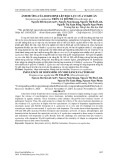
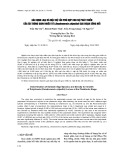
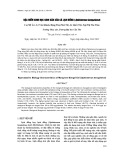

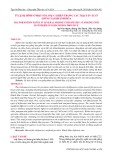
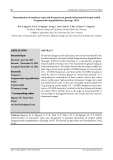
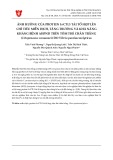
![Giáo trình Sinh lý động vật thủy sinh (Nghề: Bệnh học thuỷ sản) - Trường Cao đẳng Cộng đồng Đồng Tháp [Trung cấp]](https://cdn.tailieu.vn/images/document/thumbnail/2022/20221012/troinangxanh10/135x160/1671665565981.jpg)





![Giáo trình Sản xuất giống tôm nước lợ, mặn (Trung cấp/Cao đẳng) - Trường Cao đẳng nghề Trà Vinh [Mới nhất]](https://cdn.tailieu.vn/images/document/thumbnail/2025/20251115/kimphuong1001/135x160/76031763179346.jpg)










